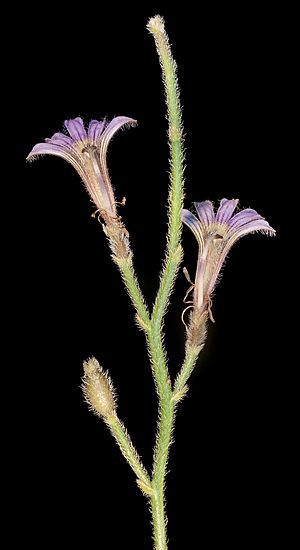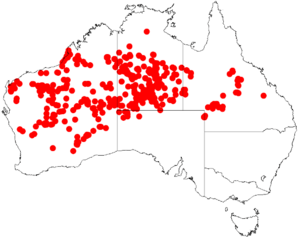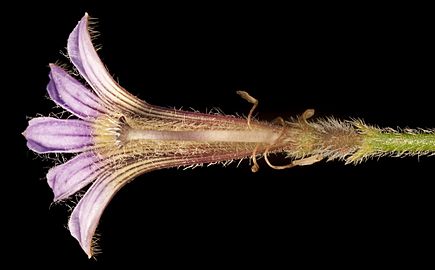Scaevola parvifolia facts for kids
Quick facts for kids Scaevola parvifolia |
|
|---|---|
 |
|
| Scientific classification | |
| Genus: |
Scaevola (plant)
|
| Species: |
parvifolia
|
 |
|
| Occurrence data from AVH | |
| Synonyms | |
|
Lobelia parvifolia Kuntze |
|
The Scaevola parvifolia plant is also known as camel weed. It is a plant that grows upright and has many stems. This plant belongs to the Goodeniaceae family. You can find it in Western Australia, the Northern Territory, Queensland, and South Australia. It can grow up to 0.6 meters (about 2 feet) tall. Its beautiful blue-purple flowers usually appear from March to October.
Contents
What Does Camel Weed Look Like?
Scaevola parvifolia is a plant that stands tall and has many stems. It can grow up to 60 centimeters (about 2 feet) high. Its stems have small hairs that stick out.
Leaves and Flowers
The leaves at the bottom of the plant do not have stalks. They are long and thin, about 18 to 35 millimeters long. The leaves on the stems are shaped more like an egg or are also long and thin. They can be 1.5 to 27 millimeters long.
The plant's flowers grow in long clusters, up to 40 centimeters long. Each flower has a stalk up to 6.5 centimeters long. The sepals, which are like small leaves protecting the flower bud, are triangular. The petals are blue to white and are 13 to 32 millimeters long. They have hairs on the outside and a beard-like fuzz on the inside.
Fruits
After the flowers, the plant produces fruits. These fruits are shaped like an oval and are 4 to 8 millimeters long. They are also hairy and have small bumps on them.
Where Does Camel Weed Grow?
You can find Scaevola parvifolia in the dry, desert-like areas of Western Australia, central Australia, and Queensland. It likes to grow in red sand, clay, or loamy soils. You will often see it on sandy plains and sand dunes.
How Was Camel Weed Named?
The plant was first described and named by a scientist named Ferdinand von Mueller in 1868. Its scientific name, parvifolia, comes from two Latin words. Parvus means "small," and folium means "leaf." So, parvifolia means "small-leaved," which describes the plant's leaves.
Images for kids



